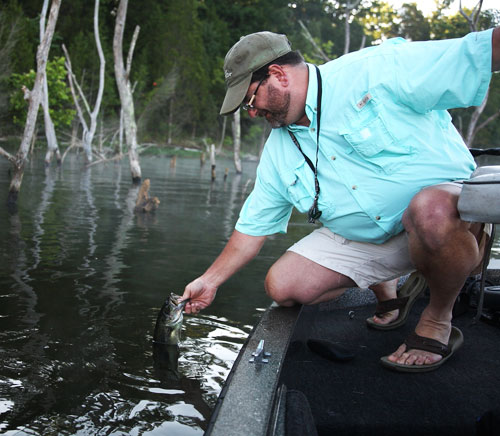BY Lee McClellan
Fishing instruction for decades preached anglers should fish deep, cool water during the hottest days of the summer.
This makes sense as fish are cold-blooded animals and their bodies are the same temperature of the water that surrounds them.
However, fishing deep water in summer on a lake such as Taylorsville Lake may mean your offerings are in a dead zone. Warming air temperatures change the nature of the water in a lake. Anglers need to consider these changes while summer fishing.

Finding the thermocline is vitally important for catching species such as largemouth bass or
channel catfish from lakes during the heat of summer.
The water column in lakes begins to stratify in late spring, like a layer cake with a warm top layer, a mixing layer in the middle and a cold layer on the bottom. Warm water is less dense and sits on top of the cooler and denser water below.
“The mixing layer in the middle is the thermocline,” said Dave Dreves, assistant director of fisheries for the Kentucky Department of Fish and Wildlife Resources. “The thermocline is a band of water with rapidly changing temperatures.”
As summer progresses, the water below the thermocline grows increasing hostile to fish. “As organic material from plants or animals sinks to the bottom, decomposition ties up all of the available dissolved oxygen,” Dreves said.
Fish need dissolved oxygen to survive, so the layer of the water below the thermocline becomes a dead zone as the air temperatures rise. Lures or bait presented there is the same as casting into a desert.
“The further you go into summer, the more the thermocline matters,” Dreves said. “It varies from year to year how long it takes for it to set up.”
Anglers want to target the area just above the thermocline for the best summer fishing. “You have that happy medium of the coolest water with good dissolved oxygen,” Dreves said. “You might find baitfish at that level as well. That zone will be the active part of the food chain.”
The fertility of the lake determines the location of the thermocline. Water clarity is a good indicator of fertility; murky lakes contain more nutrients in the water than lakes where you can see the bottom in 12 feet of water.
On a highly fertile lake such as Taylorsville, the thermocline starts at about 8 feet deep in mid-summer and ends at roughly 12 feet. Bass anglers fishing a heavy jig 18 feet deep on a channel drop are wasting their time, the same as anglers dunking cut bait for channel cats at that depth. There is no dissolved oxygen that deep.
Anglers need to pound that water from 6 to 10 feet deep or so in the summer heat on Taylorsville for bass, crappie, catfish and even bluegill.
“On a clear, low fertility lake like Laurel River Lake or Lake Cumberland, the thermocline may start at 30 feet deep,” Dreves said. “On these lakes, there can be good dissolved oxygen below the thermocline. They have a two story fishery where cool water fish such as walleye or striped bass locate below the thermocline in summer.”
On mid-depth, moderately fertile lakes such as Nolin River Lake, Barren River Lake, Green River Lake or Rough River Lake, the thermocline usually starts around 11 to 12 feet deep in summer with little dissolved oxygen below 16 feet.
“Find banks, channel drops or humps at that depth and fish them,” Dreves said. “I always remind myself to fish the right depth in summer.”
The U.S. Army Corps of Engineers Louisville District webpage has charts showing the water temperature and depths of the dissolved oxygen at www.lrl.usace.army.mil. Click on the “Water Information” tab, then the “Lake Temperatures and Dissolved Oxygen Levels” tab.
The depth where the oxygen line takes a left toward the zero side of the graph is the top of the thermocline. “You can also go out in the middle of the lake and turn up the sensitivity on your sonar unit until you see a band in the depths,” Dreves said. “That band is the thermocline. It seems the older units might pick this band up better than the newer ones.”
Lakes with high flow through rates such as Kentucky Lake and Lake Barkley usually do not form thermoclines in summer in the main lake, but thermoclines may appear in their major creek arms or embayments. The current in rivers prevents thermoclines from forming.
Remember the role of the thermocline while fishing this summer. It will put more fish in hand.
Author Lee McClellan is a nationally award-winning associate editor for Kentucky Afield magazine, the official publication of the Kentucky Department of Fish and Wildlife Resources. He is a life-long hunter and angler, with a passion for smallmouth bass fishing.
The Kentucky Department of Fish and Wildlife Resources manages, regulates, enforces and promotes responsible use of all fish and wildlife species, their habitats, public wildlife areas and waterways for the benefit of those resources and for public enjoyment. Kentucky Fish and Wildlife is an agency of the Tourism, Arts and Heritage Cabinet. For more information on the department, visit our website at fw.ky.gov.


Be the first to comment